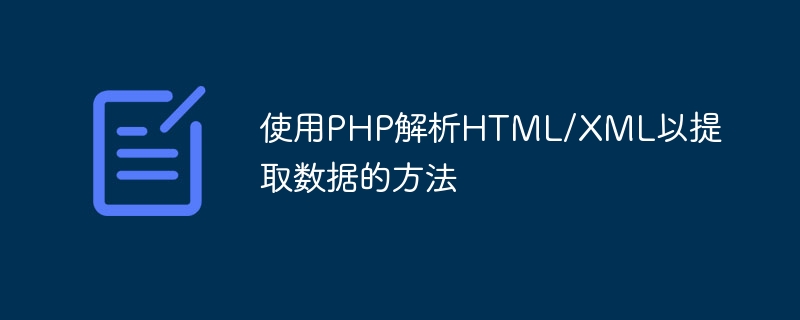

How to use PHP to parse HTML/XML to extract data
In web development, it is often necessary to extract data from HTML or XML files. PHP provides many built-in functions and libraries to parse HTML and XML and extract the required data in a concise manner. This article will introduce several methods of using PHP to parse HTML/XML, and attach code examples.
The DOMDocument class is a built-in class provided by PHP for parsing HTML and XML. It creates a Document Object Model (DOM), allowing us to traverse and manipulate documents using DOM methods and properties.
The following is an example of using the DOMDocument class to parse an HTML file:
$html = file_get_contents('example.html'); $dom = new DOMDocument(); $dom->loadHTML($html); $element = $dom->getElementById('example-element'); $data = $element->nodeValue; echo $data;
In the above code, we first use thefile_get_contentsfunction to read the contents of the HTML file into In variable$html. Then, we created a DOMDocument object$domand used theloadHTMLmethod to load the HTML content into it.
Next, we use thegetElementByIdmethod to get the element with the idexample-elementin the HTML, and use thenodeValueattribute to get its text content. Finally, we output the required data.
The SimpleXML extension is another way of parsing XML provided by PHP. It enables us to access and manipulate XML files in a simple and intuitive way.
The following is an example of parsing an XML file using the SimpleXML extension:
$xml = file_get_contents('example.xml'); $data = simplexml_load_string($xml); $item = $data->item[0]; $title = $item->title; $description = $item->description; echo $title; echo $description;
In the above code, we first read the contents of the XML file into a variable using thefile_get_contentsfunction$xmlin. Next, we use thesimplexml_load_stringfunction to convert the XML string into a SimpleXMLElement object.
We can then directly access and extract the required data through the object's properties and methods. In the example, we extract thetitleanddescriptionattributes of the firstitemelement and output them.
In addition to PHP's built-in parsing methods, there are some third-party PHP libraries that can be more flexible and efficiently parse HTML and XML files.
For example, Guzzle is a widely used PHP HTTP client library that can be used to request HTML and XML pages and provides convenient methods for parsing and extracting data.
The following is an example of using the Guzzle library to parse HTML files:
require 'vendor/autoload.php'; use GuzzleHttpClient; use SymfonyComponentDomCrawlerCrawler; $client = new Client(); $response = $client->request('GET', 'http://example.com'); $html = $response->getBody(); $crawler = new Crawler($html); $data = $crawler->filter('h1')->text(); echo $data;
In the above code, we first introduce the Guzzle library using therequirestatement. Then, we created a GuzzleHttpClient object to send HTTP requests and get HTML pages.
Next, we pass the HTML content of the page to the constructor of the SymfonyComponentDomCrawlerCrawler class to create a Crawler object. The Crawler class provides powerful filter methods. We can use thefiltermethod to specify the desired element and thetextmethod to extract its text content.
Finally, we output the required data.
Summary:
Whether using PHP's DOMDocument class, SimpleXML extension, or a third-party library, parsing HTML and XML files to extract data is a very common and important task. Through corresponding methods and tools, we can easily obtain the required data from HTML and XML to achieve various data extraction and processing needs. I hope this article will be helpful to you when using PHP to parse HTML/XML.
References:
The above is the detailed content of How to parse HTML/XML to extract data using PHP. For more information, please follow other related articles on the PHP Chinese website!